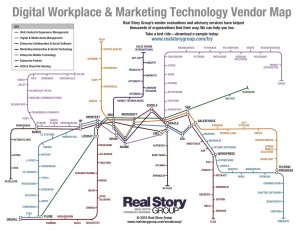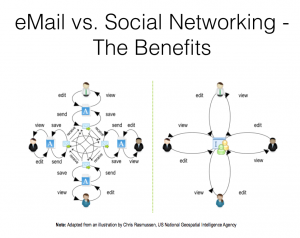As the book Patricia Eng and I are writing takes shape – we spent a productive couple of days last week editing chapters and agreeing key points for those still to be completed – so my thoughts continue to evolve as to the future role (and skills needed) to be a Knowledge (and Information) Manager.
This week I am charged with delivering a provocative ‘wake up’ call when I speak to the annual conference of the Chartered Institute of Libraries & Information Professionals (CILIP). Here’s the gist of what I am going to say,
Operational KM to the Fore: Strategic KM to the rear
- The majority of KM programs appear to be operationally focused addressing a burning platform issue or an urgent business problem.
- These tactical programs address risk (loss of knowledge due to downsizing, retirement, reorganization or acquisition). Some focus on being more efficient and meeting internal and external quality standards.
- Few it seems are driven strategically as a result of visionary leadership and if you look at where KM is located most surveys reveal its part of an operations division or unit. Rarely is a Chief Knowledge Officer part of the C-Suite of an organization. Often KM is treated like a hot potato.
- Less than 1 in 5 are strategically aligned. Where they are its because Knowledge is perceived to be the core product of that organisation.
- The downside of being operationally driven is that when the burning platform issue or business problem is resolved KM is often left looking for a rationale for being and a new sponsor.
Step forward the ‘Knowledgeur’
So what can KM’ers or KIM’ers’ do, how can they protect themselves and their programme? For some time I’ve suggested that the Knowledge Manager needs to have facilitation and social skills that make them the ‘go to’ person in an organisation. Someone who makes and nurtures connections. Here’s my definition of that person I call a Knowledgeur:
‘A Knowledge Manager (Knowledgeur) is someone who makes use of his/her/others’ knowledge in one activity or market and applies it for beneficial use in another.
Originally inward facing the role is becoming more outward facing with the rise of communities and the subsequent need to collaborate outside of the organisation.’
The Skills (‘…ates) of a Knowledgeur
Here’s what I think you will need to do to if you are to perform this role:
- Investigate: Are you putting a burning fire out / solving an immediate business need / addressing a risk (Operational KM) or is this driven by the vision from the top consistent with the organisation’s business direction (Strategic KM)?
- Navigate: Work out / Map the critical knowledge areas of your organisation and create a directory of the organisation’s knowledge assets.
- Negotiate: Agree the scope of your role with your sponsors and be tough negotiating what success will look like and how it’s measured.
- Facilitate: So much of what a KM Manager does involves facilitation. You will become a hub knowing who to go to to ask if you don’t know yourself. You have to facilitate connections, meetings, interactions, events and communities. This requires resilience, a lot of social skills and a real understanding of cultural nuances.
- Collaborate: You are in alliance with business areas and occasionally external suppliers or partners. You have to be capable of virtual cross border collaboration.
- Communicate: Senior KM’er’s tell you to devote 30% of your time to communicating what you do and getting feedback – its not just about broadcasting. Have your KM Elevator pitch always with you. Let all your stakeholders know what you are doing and why.
- Curate: So much of what passes for Knowledge Management is about creating and storing content and making it available for reuse. It’s more than the role formerly undertaken by Information Professionals and Librarians, here we are talking about being a custodian of organisational knowledge and organisational knowledge bases.
- Celebrate: The role can be a lonely one as reporting lines and sponsors change, yours is a cost not revenue line and the initial burst of enthusiasm fades. Collect stories, be prepared to acknowledge contributions and celebrate successes.
My address ‘The changing KM landscape, the future of KM and our role in it as KM professionals‘ will look at each of these ‘…ates in more detail.
And finally
I am looking forward to seeing the response I provoke at Wednesday’s event at Brighton. Watch this space!

 Today was a case in point. As I got to the seafront I was approached by an Indian man who looked lost.
Today was a case in point. As I got to the seafront I was approached by an Indian man who looked lost. My second strange encounter was to find two paramedics and an ambulance on the promenade by one of the thatched beach shelters which are used in good weather as overnight accommodation by those who have none.
My second strange encounter was to find two paramedics and an ambulance on the promenade by one of the thatched beach shelters which are used in good weather as overnight accommodation by those who have none. In the case of Patient Access I imagine engagement is a bigger challenge due to its wider range of potential users than in a business environment where focus is on Baby Boomer to Generation Z .
In the case of Patient Access I imagine engagement is a bigger challenge due to its wider range of potential users than in a business environment where focus is on Baby Boomer to Generation Z . in constant anticipation and it kept my interest throughout. Great for a 5 hour plane ride.
in constant anticipation and it kept my interest throughout. Great for a 5 hour plane ride.

 I was really taken by the closing Keynote from Tony Byrne of
I was really taken by the closing Keynote from Tony Byrne of Luis ran the morning and I ran the afternoon. His method and justification for lowering email usage are compelling and I loved this slide that shows how a social networking platform can be a lot more efficient than using email.
Luis ran the morning and I ran the afternoon. His method and justification for lowering email usage are compelling and I loved this slide that shows how a social networking platform can be a lot more efficient than using email.








